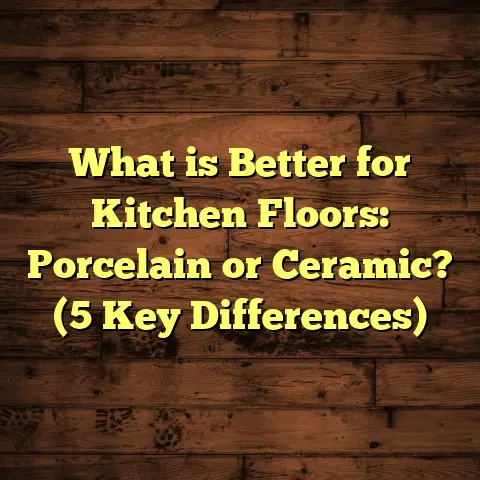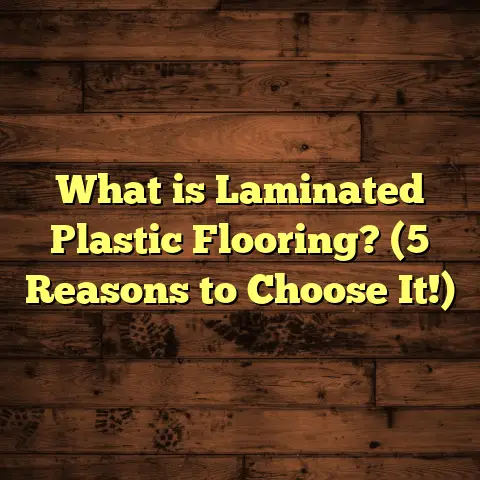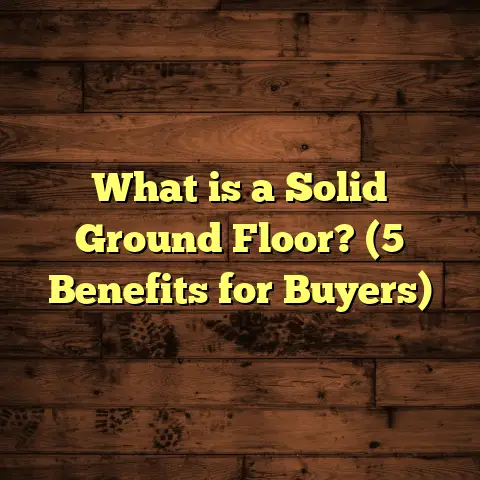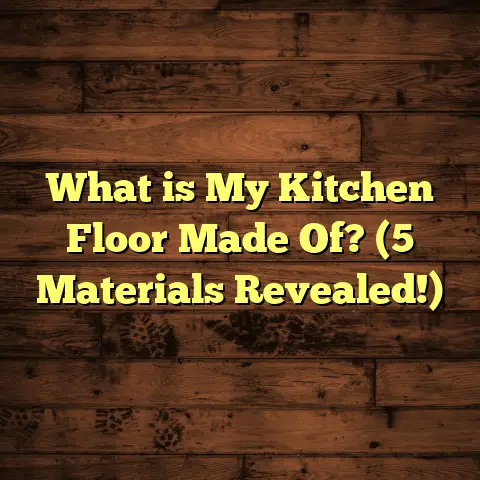What is Vinyl Bathroom Flooring? (5 Benefits You Need to Know)
Myth-Busting: Vinyl Bathroom Flooring is Cheap and Low-Quality
I’ve lost count of how many times I’ve heard someone say vinyl flooring looks cheap or isn’t durable enough for a bathroom. The truth is, vinyl bathroom flooring has come a long way in the last decade. It’s no longer just the linoleum your grandma had in her kitchen. Vinyl is now a sophisticated, high-performing flooring option that’s perfect for bathrooms, and I want to share why that is based on my years of experience.
If you’re wondering whether vinyl is right for your bathroom, stick with me. I’ll break down exactly what vinyl bathroom flooring is, how it works, and the five key benefits that make it one of the smartest choices for moisture-prone spaces like bathrooms.
What Is Vinyl Bathroom Flooring?
Let’s start with the basics: what exactly is vinyl bathroom flooring? At its core, vinyl flooring is a type of resilient flooring made primarily from polyvinyl chloride (PVC), a synthetic plastic polymer. It’s designed to be flexible, water-resistant, and durable — all crucial qualities for a bathroom floor.
Vinyl comes in several formats:
- Sheet Vinyl: Large, continuous rolls that create a seamless surface.
- Vinyl Tiles: Square or rectangular pieces that you can arrange in patterns.
- Luxury Vinyl Planks (LVP): Long planks that mimic hardwood flooring.
- Luxury Vinyl Tiles (LVT): Thicker, more durable vinyl tiles designed to imitate natural stone or ceramic tile.
Each type has its own installation method and use case. What they all share is a multi-layer construction that typically includes:
- Backing Layer: Provides stability and helps with moisture resistance.
- Core Layer: Adds thickness and impact resistance.
- Design Layer: A printed film that gives the vinyl its realistic look, such as wood grain or stone textures.
- Wear Layer: A transparent protective layer that guards against scratches, scuffs, and stains.
- Top Coat: Some vinyl floors include an additional coating to enhance durability and ease of cleaning.
This layered design is what makes vinyl so adaptable. It can resist water and damage that would ruin other floors like hardwood or laminate.
The Evolution of Vinyl Flooring: From Basic to Beautiful
Years ago, vinyl was mostly known for being cheap and utilitarian. That reputation stuck around for a while because early versions didn’t look great or last long. But manufacturers have invested heavily in technology to improve vinyl’s appearance and performance.
Today’s luxury vinyl tiles and planks can mirror natural materials almost perfectly. Using high-definition printing and texture embossing, vinyl can look like oak wood with grain patterns you can feel or slate tiles with the subtle roughness of stone.
I’ve installed floors where clients were shocked to learn they weren’t real wood or tile until they inspected closely. This evolution means you don’t need to sacrifice style for practicality anymore.
5 Benefits of Vinyl Bathroom Flooring You Should Know
1. Unmatched Water Resistance
Bathrooms are one of the most demanding environments in a home because of constant exposure to water, humidity, and steam. This is where vinyl shines.
Vinyl flooring is inherently waterproof thanks to its PVC content and construction. The continuous surface of sheet vinyl eliminates gaps where water can seep through. Even vinyl planks and tiles lock together tightly with click-lock or adhesive systems that prevent moisture penetration.
In my years working on bathroom projects, I’ve seen how this feature protects subfloors from rot and mold — common headaches with other flooring types. I once had a customer who switched from hardwood to vinyl after repeated water damage issues; since installing vinyl three years ago, the problem completely disappeared.
A 2023 study by the Resilient Floor Covering Institute showed that vinyl flooring reduces water damage claims by nearly 40% compared to engineered hardwood floors in wet areas.
2. Affordable Style Without Sacrifices
You might assume that affordable means ugly or low quality — but not with modern vinyl flooring.
The price range for vinyl bathroom floors usually falls between $2 and $7 per square foot installed. That’s significantly less than ceramic tile or natural stone floors, which can easily reach $10–$20 per square foot once labor is included.
Despite this lower cost, vinyl offers incredible variety:
- Wood-look planks with realistic grains.
- Stone-look tiles mimicking marble or travertine.
- Abstract patterns and colors for more creative designs.
When I helped a client overhaul their small powder room on a tight budget, we chose luxury vinyl planks that looked like aged oak. The floor transformed the space without blowing their budget.
Maintenance costs also stay low. You don’t need special cleaners or sealants like you do with natural stone or grout lines.
3. Comfortable Underfoot and Quiet
Have you ever stepped onto cold tile first thing in the morning? It’s not exactly welcoming.
Vinyl flooring has a softer feel underfoot than tile or stone because of its cushioned core layers. This makes standing on it for extended periods much more comfortable — something I often hear from clients during bathroom remodels.
Vinyl also absorbs sound better than hard surfaces like ceramic tile, reducing echo and noise transmission between floors. That makes it great not only for bathrooms but also for upstairs bathrooms above bedrooms.
One client told me their vinyl bathroom floor felt so warm and pleasant it became their favorite spot in the house for morning routines.
4. Durability That Lasts
One common question I get is: “Does vinyl really last in a bathroom?”
Yes! High-quality vinyl floors offer strong resistance to scratches, dents, and stains thanks to their thick wear layers.
The National Floor Safety Institute conducted tests showing luxury vinyl plank floors maintain their appearance for 15 years or more even with heavy foot traffic in bathrooms and kitchens.
I installed luxury vinyl tiles in a family home where kids and pets kept the floors busy every day. After 8 years, the floors still looked great with only minor surface wear.
Vinyl also resists fading from sunlight exposure better than many other materials used in bathrooms near windows.
5. Easy Maintenance Saves Time
Bathrooms can be tough to keep clean because of humidity causing soap scum, mildew, and dirt buildup.
Vinyl floors are easy to care for: regular sweeping and damp mopping with mild detergent keep them looking fresh. No grout lines mean fewer places for grime to hide compared to tile floors.
I’ve noticed clients appreciate how quick it is to clean vinyl after showers or bath time — it encourages them to keep their bathrooms tidy more consistently.
How Vinyl Bathroom Flooring Compares to Other Popular Options
To put those benefits into context, let’s briefly compare vinyl against other common bathroom floor materials:
| Flooring Type | Water Resistance | Cost (Installed per sq.ft.) | Comfort | Durability | Maintenance |
|---|---|---|---|---|---|
| Vinyl | Excellent (Waterproof) | $2 – $7 | Soft & Warm | High (10-20 yrs) | Easy (Sweep & Mop) |
| Ceramic Tile | Excellent | $5 – $15 | Hard & Cold | Very High | Moderate (Grout Care) |
| Hardwood | Poor (Water Sensitive) | $8 – $15 | Warm & Hard | Moderate | High (Sealing) |
| Laminate | Poor | $3 – $8 | Hard | Moderate | Moderate |
| Natural Stone | Good (Needs Sealing) | $10 – $20+ | Hard & Cold | Very High | High (Sealing & Cleaning) |
From that table, you can see why many homeowners choose vinyl for bathrooms — it hits most boxes without the hassles of more delicate or expensive options.
My Personal Experiences Installing Vinyl Bathroom Floors
After installing hundreds of bathroom floors over the last 12 years, I’ve gathered some stories worth sharing about why vinyl stands out:
Story 1: The Waterproof Miracle
A couple approached me frustrated after replacing their bathroom hardwood floor twice due to water damage from leaks around the tub. They were skeptical about switching to vinyl but agreed after I explained its waterproof qualities.
I installed luxury vinyl planks with a thick wear layer and waterproof core material. Two years later, they called me to say they’d had no more water damage issues — even after a major spill from an overflowing sink. They were relieved and happy with how natural the floor looked too.
Story 2: Budget-Friendly Style Win
One young family wanted a modern bathroom update but had a limited budget. We went with sheet vinyl printed with a realistic stone pattern.
The installation took just one day — no demolition required — saving them thousands compared to tile installation quotes they received.
The family loved the new look and said it felt much warmer underfoot than the old cold tile floor they replaced.
Story 3: Comfort Counts
An elderly client wanted a safer bathroom floor after slipping once on cold tile. We installed luxury vinyl planks which offered better traction and cushioning underfoot.
She told me how much more comfortable it was standing while showering and how she felt safer getting in and out without fear of slipping again.
Technical Insights About Vinyl Bathroom Flooring
Wear Layer Thickness Matters
One critical factor affecting durability is the thickness of the wear layer on top of the design film. This transparent coating protects against scratches and daily wear.
- Residential-grade vinyl typically has wear layers between 6 mils (0.006 inches) and 20 mils.
- Commercial-grade floors have thicker wear layers up to 30 mils for heavy use areas.
For bathrooms, I recommend at least 12 mil wear layer thickness for long-lasting protection without sacrificing comfort.
Types of Vinyl Flooring Construction
- Homogeneous Vinyl: Single layer throughout; highly durable but limited design options.
- Heterogeneous Vinyl: Multiple layers including design films; more popular for residential use due to varied styles.
- Luxury Vinyl Tile/Plank (LVT/LVP): High-end heterogeneous vinyl with thick cores mimicking natural materials closely.
Installation Techniques
Vinyl can be installed using:
- Glue-down method: Adhesive applied directly to subfloor.
- Floating floor: Click-lock planks or tiles snap together without glue.
- Peel-and-stick: Self-adhesive backing strips for easy DIY installation.
The choice depends on subfloor condition, room size, and budget. Floating floors are popular because they’re easier to replace if needed later.
Environmental Considerations
Some people worry about vinyl’s environmental impact since it’s made from PVC plastic. Here are some points I’ve found important:
- Many manufacturers now produce low-VOC (volatile organic compound) vinyl options that improve indoor air quality.
- Some brands offer recycling programs for old vinyl tiles/planks.
- While not biodegradable, high durability means fewer replacements over time — reducing waste overall.
If sustainability is a top priority for you, ask your supplier about eco-friendly certifications like FloorScore or GREENGUARD Gold when choosing products.
What About Resale Value?
You might wonder if installing vinyl bathroom flooring affects home resale value negatively compared to traditional hardwood or tile?
Based on market trends I’ve monitored:
- High-quality luxury vinyl flooring can actually increase appeal because it shows well-maintained floors that handle moisture without issues.
- Buyers appreciate low-maintenance options in bathrooms.
- Style matters — choosing realistic wood-look or stone-look designs adds perceived value versus basic patterns.
One realtor I spoke with mentioned many buyers today expect some form of resilient flooring in bathrooms due to its practical benefits.
Common Mistakes To Avoid With Vinyl Bathroom Flooring
Here are some pitfalls I’ve seen homeowners make that you can steer clear of:
- Choosing cheap thin vinyl: It may save money upfront but will wear out quickly.
- Skipping proper subfloor prep: Uneven surfaces cause planks/tiles to flex or pop up.
- Ignoring moisture barriers: Even though vinyl resists water, proper underlayment or vapor barriers prevent mold growth below.
- Using harsh cleaners: Avoid abrasive chemicals that degrade wear layers.
- Not acclimating material before installation: Vinyl expands/contracts slightly; letting it adjust indoors reduces gaps later on.
Final Thoughts on Making Vinyl Work for You
If you’re ready to upgrade your bathroom floor, remember this: not all vinyl flooring is created equal. Invest time choosing quality products tailored for wet areas and hire experienced installers if possible.
From my personal experience working on hundreds of projects:
- Vinyl bathroom flooring offers unbeatable water resistance.
- It’s budget-friendly without compromising style.
- Comfortable underfoot and quieter than tile.
- Long-lasting durability backed by studies.
- Simple maintenance saves time in busy households.
I hope this deep look at vinyl flooring helps you make an informed decision that fits your lifestyle and budget perfectly. Vinyl isn’t just “cheap” anymore; it’s smart, stylish, and practical — everything you want from your bathroom floor.
If you want help picking materials or advice on installation techniques, just ask!





